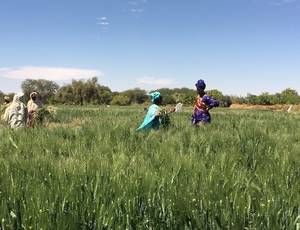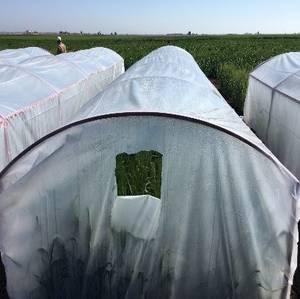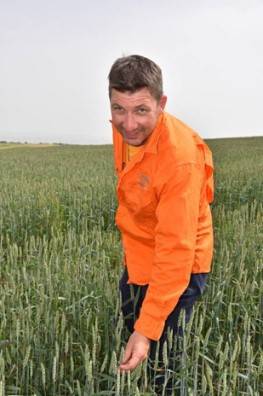Wheat to beat the heat
Adapted from a blog by Jacques Wery, ICARDA Deputy Director General – Research, originally posted on the International Center for Agriculture in the Dry Areas (ICARDA) website.

Western Europe is in the midst of an intense heat wave that started at the end of June. The southern French commune of Villevieille recorded a temperature of 45.1 °C, breaking the country’s all-time record. The heat also set new temperature records in Germany and the Czech Republic. Other countries like Italy, Spain and Portugal are also gripped with temperatures much higher than normal.
Scientists have attributed the soaring temperatures to the combination of a storm over the Atlantic Ocean and high pressure over central Europe, which is importing hot air from the Sahara. Though heat waves are not uncommon in Europe, this one was unusually early. Experts say climate change is making heat waves more common (Global warming of 1.5 °C IPCC Special Report).
Apart from human health, the heat wave is already causing significant damage in agriculture. Major wheat growers experienced temperatures of 40 °C and higher. This is of great concern, as the heat wave occurred during the crop’s critical growth stages. Wheat is a cool season crop with an optimal daytime growing temperature of 15 °C during the critical reproductive stage. Wheat plants exposed to high temperatures around the period of flowering lose fertility due to pollen dehydration, resulting in less grain formed. It is calculated that for every degree above the optimum 15 °C, wheat experiences a yield reduction of three to four percent.
If a heat wave like such as this one had occurred one month earlier, at the end of May, when Northern European wheat is in full bloom, it could have caused up to 50 percent yield loses, a devastating blow to the European agriculture and food sectors costing billions of Euros.
The response of scientists
Breeding heat tolerant wheat varieties remains one of the most strategic approaches to cope with the risk of unseasonal heat waves. The International Center for Agricultural research in Dry Areas (ICARDA) started in 2012 to use field stations that experience continuous heat-stress to select new wheat cultivars better primed to tolerate this stress.
In Sudan, the experimental farm of Wad Medani was developed together with the Agricultural Research Corporation (ARC) and CIMMYT (International Center for Maize and Wheat Improvement), to test thousands of wheat candidate varieties each year. This station experiences average maximum daily temperatures above 30 °C throughout the growing season, which is less than 100 days long, from planting to harvest. This test was used to identify critical genes controlling heat-tolerant in common wheat, and to release new cultivars of bread wheat and durum wheat capable of withstanding severe heat.

Similarly, two heat-stress experimental farms were developed in West Africa to test durum wheat germplasm. In collaboration with Prof Rodomiro Ortiz of the Swedish University of Agricultural Sciences (SLU) Department of Plant Breeding, the stations of Kaédi in Mauritania and Fanaye in Senegal were upgraded in partnership with the Centre National de Recherche Agronomique et de Développement Agricole (CNRADA) and the Institut Sénégalais de Recherche Agricole (ISRA).
Field testing conducted at these stations – with daily temperatures above 32 °C throughout the cycle and a season of only 90 days – have revealed four new durum wheat cultivars perfectly adapted to tolerate intense heat. The work conducted in West Africa has even resulted in the awarding of the prestigious OLAM Prize for Innovation in Food Security to the team of researchers involved.
To convert this success into cultivars that could be grown, heat tolerance must be combined with the ability to cope with drought stress. An experiment was devised at the Marchouch station in Morocco, where plastic tunnels were placed on the wheat plants at the time of flowering to raise temperatures to above 40 °C and simultaneously prevent any rainfall from reaching the plants.

When all other tested varieties lost more than 50 percent yield to the two combined stresses, the ICARDA-INRA (Institut Nationale de la Recherche Agronomique in Morocco) cultivar Faraj lost only 25 percent, a major positive result considering the severity of the stresses tested. Along the same principles, more than 60 wheat varieties of ICARDA origin have been released by national breeding programs in Central and West Asia and North Africa regions and sub- Saharan Africa regions in the last five years alone, thanks to the ability of the germplasm to adapt to some of the most severe wheat stresses occurring around the world.
Can Europe take advantage of success stories?
In the USA and Canada, farmers grow mostly wheat varieties developed and commercialized by public wheat breeding programs. These cultivars have been very popular and public sector wheat-breeding activities are vital to the industry.
In Australia, wheat breeding is conducted by the private sector. However, public researchers are spending the same amount of money on pre-breeding as they did 10 years ago on breeding and variety development together. To take advantage of some of the success stories of ICARDA and CIMMYT, the Australian wheat breeding programs established 10 years ago the CIMMYT-Australia-ICARDA Germplasm Evaluation project (CAIGE). Each year, Australian breeders visit the trials of ICARDA in Morocco and CIMMYT in Mexico. They select the top high yielding wheat genotypes that combine drought and heat tolerance, with other useful traits. These are then imported and tested across Australian sites to confirm the best one for commercialization or use in hybridization programs.

In Europe, the situation is more like Australia, and public researchers do not work directly on the commercialization and development of varieties, which is left to the private companies. Instead, public research focuses on pre-breeding to develop new breeding techniques and on high-risk, longer-term targets, thereby supporting the private sector and farmers with high-tech innovations.
CGIAR centers such as ICARDA and CIMMYT have worked in close collaboration with European universities and advanced research institutions for a long time to develop and adapt the most novel technologies for pre-breeding. It might also be advantageous for European private sector companies to start taking advantage of CGIAR stress-tolerant wheat varieties and develop a system similar to CAIGE used by Australian breeders. By taking advantage of similar environments in Morocco and Mediterranean environments in Europe, European breeders can select promising germplasm of tomorrow and provide the continent’s agricultural sector with a practical defense against future heat waves.




